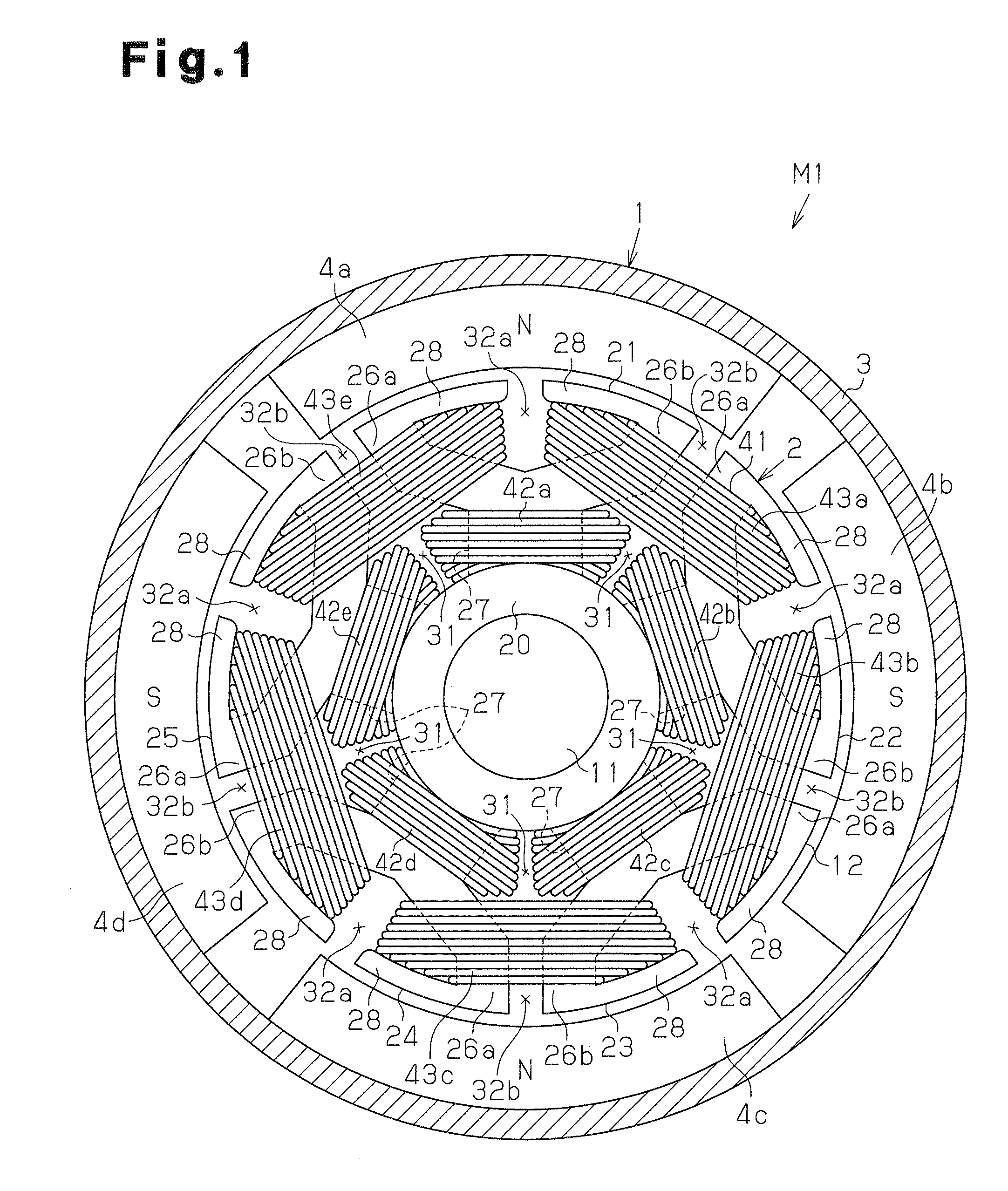Direct-current motor and manufacturing method for the direct-current motor
a manufacturing method and technology of direct-current motor, applied in the direction of windings, stator/rotor bodies, solid insulation, etc., can solve the problems of generating great vibration on the direct-current motor, reducing the power output and the size of the direct-current motor is undesirably increased, so as to prevent the effect of being enlarged and preventing vibration
- Summary
- Abstract
- Description
- Claims
- Application Information
AI Technical Summary
Benefits of technology
Problems solved by technology
Method used
Image
Examples
first embodiment
[0053]the present invention will now be described with reference to drawings.
[0054]FIG. 1 shows a cross-sectional view of a direct-current motor M1 according to the first embodiment. The direct-current motor M1 includes a stator 1 and an armature 2 as shown in FIG. 1. The stator 1 includes a substantially cylindrical yoke housing 3. Four magnets 4a to 4d serving as magnetic poles are attached to the inner circumferential surface of the yoke housing 3. The magnets 4a to 4d are arranged at equal angular intervals (in the present embodiment, intervals of 90°) in the circumferential direction. The magnets 4a to 4d are arranged such that the north poles and the south poles are alternately arranged in the circumferential direction. The number of the magnetic poles P of the direct-current motor M1 is four.
[0055]As shown in FIGS. 1 and 2, the armature 2 is arranged radially inward of the stator 1. The armature 2 includes a rotary shaft 11, a substantially columnar armature core 12, which is...
third embodiment
[0120]FIG. 14 shows a diagrammatic developed view of the direct-current motor M4. The direct-current motor M4 differs from the direct-current motor M3 of the third embodiment in the structure of outer layer coils 203a to 203h in the armature 201.
[0121]Eight inner layer coils 202a to 202h and eight outer layer coils 203a to 203h are wound around the armature core 142 as in the third embodiment. The outer layer coils 203a to 203h that are wound around the circumferentially adjacent two branched tooth portions 26a, 26b of the circumferentially adjacent teeth include inner coil portions 211a to 211h that are wound around the proximal end of the branched tooth portions 26a, 26b and outer coil portions 212a to 212h that are wound around the distal end of the branched tooth portions 26a, 26b. In FIG. 14, the inner layer coils 202a to 202h are shown by medium lines, the inner coil portions 211a to 211h are shown by alternate long and short dash lines, and the outer coil portions 212a to 212...
fifth embodiment
[0129]the present invention will now be described with reference to the drawings. In the present embodiment, the same reference numerals are given to those components that are the same as the corresponding components of the first to fourth embodiments and detailed explanations are omitted.
PUM
| Property | Measurement | Unit |
|---|---|---|
| Length | aaaaa | aaaaa |
| Diameter | aaaaa | aaaaa |
| Electrical resistance | aaaaa | aaaaa |
Abstract
Description
Claims
Application Information
 Login to View More
Login to View More - R&D
- Intellectual Property
- Life Sciences
- Materials
- Tech Scout
- Unparalleled Data Quality
- Higher Quality Content
- 60% Fewer Hallucinations
Browse by: Latest US Patents, China's latest patents, Technical Efficacy Thesaurus, Application Domain, Technology Topic, Popular Technical Reports.
© 2025 PatSnap. All rights reserved.Legal|Privacy policy|Modern Slavery Act Transparency Statement|Sitemap|About US| Contact US: help@patsnap.com



